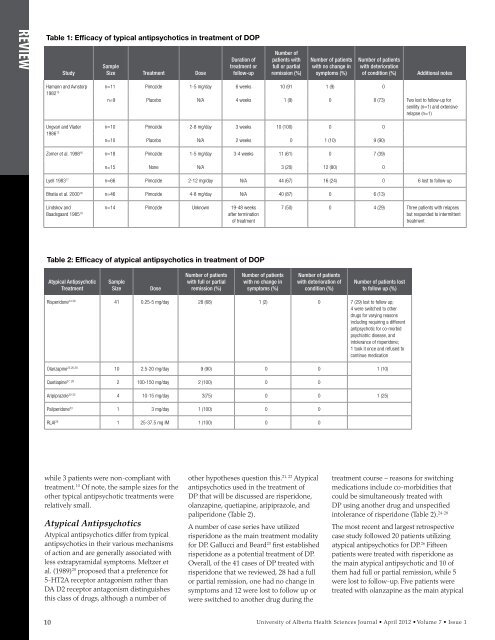MUSA - Alberta Pharmacy Students' Association
MUSA - Alberta Pharmacy Students' Association
MUSA - Alberta Pharmacy Students' Association
You also want an ePaper? Increase the reach of your titles
YUMPU automatically turns print PDFs into web optimized ePapers that Google loves.
REVIEW<br />
Table 1: Efficacy of typical antipsychotics in treatment of DOP<br />
10<br />
Study<br />
Hamann and Avnstorp<br />
1982 15<br />
Ungvari and Vlader<br />
1986 13<br />
Sample<br />
Size Treatment Dose<br />
Duration of<br />
treatment or<br />
follow-up<br />
Number of<br />
patients with<br />
full or partial<br />
remission (%)<br />
Number of patients<br />
with no change in<br />
symptoms (%)<br />
n=11 Pimozide 1-5 mg/day 6 weeks 10 (91 1 (9) 0<br />
Number of patients<br />
with deterioration<br />
of condition (%) Additional notes<br />
n=9 Placebo N/A 4 weeks 1 (9) 0 8 (73) Two lost to follow-up for<br />
senility (n=1) and extensive<br />
relapse (n=1)<br />
n=10 Pimozide 2-8 mg/day 3 weeks 10 (100) 0 0<br />
n=10 Placebo N/A 2 weeks 0 1 (10) 9 (90)<br />
Zomer et al. 1998 16 n=18 Pimozide 1-5 mg/day 3-4 weeks 11 (61) 0 7 (39)<br />
n=15 None N/A 3 (20) 12 (80) 0<br />
Lyell 1983 17 n=66 Pimozide 2-12 mg/day N/A 44 (67) 16 (24) 0 6 lost to follow-up<br />
Bhatia et al. 2000 18 n=46 Pimozide 4-8 mg/day N/A 40 (87) 0 6 (13)<br />
Lindskov and<br />
Baadsgaard 1985 19<br />
n=14 Pimozide Unknown 19-48 weeks<br />
after termination<br />
of treatment<br />
Table 2: Efficacy of atypical antipsychotics in treatment of DOP<br />
Atypical Antipsychotic<br />
Treatment<br />
Sample<br />
Size Dose<br />
Number of patients<br />
with full or partial<br />
remission (%)<br />
Number of patients<br />
with no change in<br />
symptoms (%)<br />
7 (50) 0 4 (29) Three patients with relapses<br />
but responded to intermittent<br />
treatment<br />
Number of patients<br />
with deterioration of<br />
condition (%)<br />
Number of patients lost<br />
to follow up (%)<br />
Risperidone 24-28 41 0.25-5 mg/day 28 (68) 1 (2) 0 7 (29) lost to follow up;<br />
4 were switched to other<br />
drugs for varying reasons<br />
including requiring a different<br />
antipsychotic for co-morbid<br />
psychiatric disease, and<br />
intolerance of risperidone;<br />
1 took it once and refused to<br />
continue medication<br />
Olanzapine 25,26,28 10 2.5-20 mg/day 9 (90) 0 0 1 (10)<br />
Quetiapine 27, 28 2 100-150 mg/day 2 (100) 0 0<br />
Aripiprazole 30-32 4 10-15 mg/day 3(75) 0 0 1 (25)<br />
Paliperidone 33 1 3 mg/day 1 (100) 0 0<br />
RLAI 29 1 25-37.5 mg IM 1 (100) 0 0<br />
while 3 patients were non-compliant with<br />
treatment. 10 Of note, the sample sizes for the<br />
other typical antipsychotic treatments were<br />
relatively small.<br />
atypical antipsychotics<br />
Atypical antipsychotics differ from typical<br />
antipsychotics in their various mechanisms<br />
of action and are generally associated with<br />
less extrapyramidal symptoms. Meltzer et<br />
al. (1989) 20 proposed that a preference for<br />
5-HT2A receptor antagonism rather than<br />
DA D2 receptor antagonism distinguishes<br />
this class of drugs, although a number of<br />
other hypotheses question this. 21, 22 Atypical<br />
antipsychotics used in the treatment of<br />
DP that will be discussed are risperidone,<br />
olanzapine, quetiapine, aripiprazole, and<br />
paliperidone (Table 2).<br />
A number of case series have utilized<br />
risperidone as the main treatment modality<br />
for DP. Gallucci and Beard23 first established<br />
risperidone as a potential treatment of DP.<br />
Overall, of the 41 cases of DP treated with<br />
risperidone that we reviewed, 28 had a full<br />
or partial remission, one had no change in<br />
symptoms and 12 were lost to follow up or<br />
were switched to another drug during the<br />
treatment course – reasons for switching<br />
medications include co-morbidities that<br />
could be simultaneously treated with<br />
DP using another drug and unspecified<br />
intolerance of risperidone (Table 2). 24-28<br />
The most recent and largest retrospective<br />
case study followed 20 patients utilizing<br />
atypical antipsychotics for DP. 26 Fifteen<br />
patients were treated with risperidone as<br />
the main atypical antipsychotic and 10 of<br />
them had full or partial remission, while 5<br />
were lost to follow-up. Five patients were<br />
treated with olanzapine as the main atypical<br />
University of <strong>Alberta</strong> Health Sciences Journal • April 2012 • Volume 7 • Issue 1


